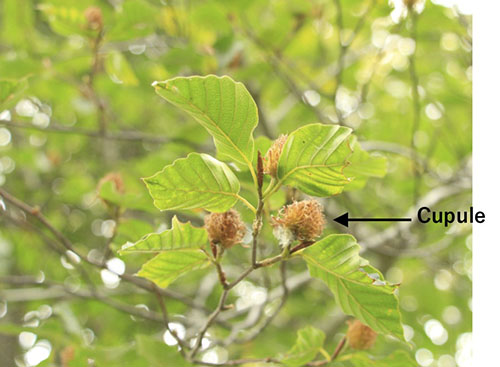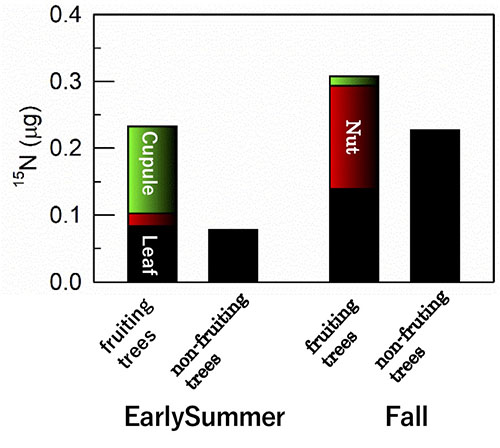Home > Research > Research Results > Research Results 2018 > Allocation of nitrogen for the production of beech nuts
Update:April 9, 2018
Main content starts here.
Allocation of nitrogen for the production of beech nuts
| Article title |
Influence of reproduction on nitrogen uptake and allocation to new organs in Fagus crenata |
|---|---|
| Author (affiliation) |
Qingmin Han (a), Daisuke Kabeya (a), Yoshiyuki Inagaki (b) (a) Department of Plant Ecology, FFPRI, Tsukuba, Ibaraki, Japan. |
| Publication Journal |
Tree Physiology, 37(10):1436-1443, November 2017, DOI:10.1093/treephys/tpx095( External link ) |
| Content introduction |
In numerous forest tree species, the amount of seeds produced in a year varies greatly depending on the year, which is called mast seeding or masting. In beech trees that are representative of the deciduous broad-leaved trees of northern Japan, the amount of nut production varies several hundred-fold between years. For understanding the basis of masting, the impact of climatic conditions and the balance between resource supply (such as carbohydrates and nitrogen) and its allocation for the growth, flowering, and fruiting have been explored. However, this hypothesis remains to be elucidated. For understanding the phenomenon of masting, we sampled leaves, branches, and nuts from both fruiting and non-fruiting beech trees on Mount Naeba and analyzed their 15N concentrations for comparing the utilization of 15N absorbed from the soil. As a result, in the early summer of 2011, 64% of the nitrogen absorbed by fruiting trees was used for the growth of acorns (Figure 1), and the remaining nitrogen was used for the growth of leaves. By contrast, trees that did not bear fruit diverted most of the absorbed nitrogen toward the growth of leaves. Because the total amount of nitrogen absorbed by non-fruiting trees was low, the amount of nitrogen diverted to leaves in these trees was comparable to that in fruiting trees. In autumn, 50% of the nitrogen absorbed by fruiting trees was used for nut ripening (Figure 2), and a part of it was translocated from the cupule (called kakuto, referring to the part enveloping the entire acorn). On the contrary, trees that did not bear fruit diverted most of the absorbed nitrogen to leaves; the amount of nitrogen allocated to leaves in trees without fruit was 1.6-fold higher than that in trees with fruit. These findings suggest that for ensuring the production of nuts, the beech tree skillfully manages the nitrogen available for use by increasing the amount of nitrogen absorbed from the soil or by diverting the nitrogen of the cupule to the nut.
Figure 1. The acorn of a beech tree. The nut grows while receiving nitrogen from the cupule, which is the outer covering of the entire acorn. Two nuts are enclosed within a single cupule.
|
Copyright © Forest Research and Management Organization. All rights reserved.


